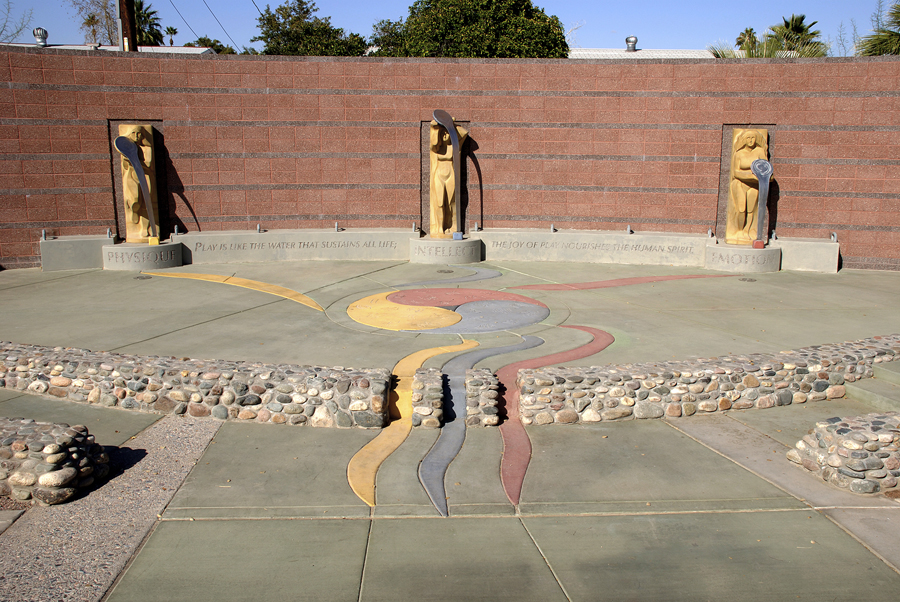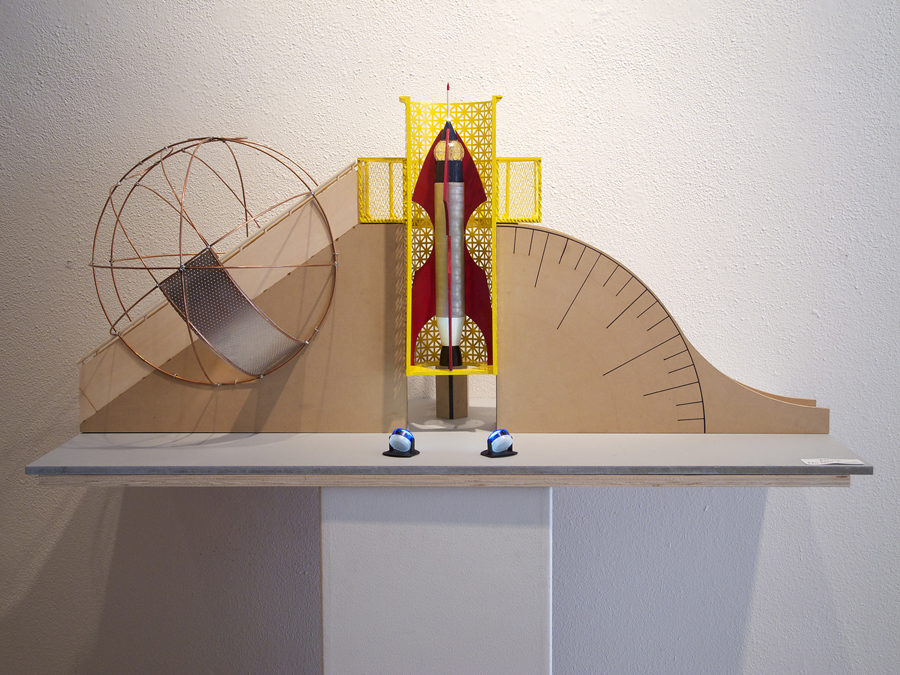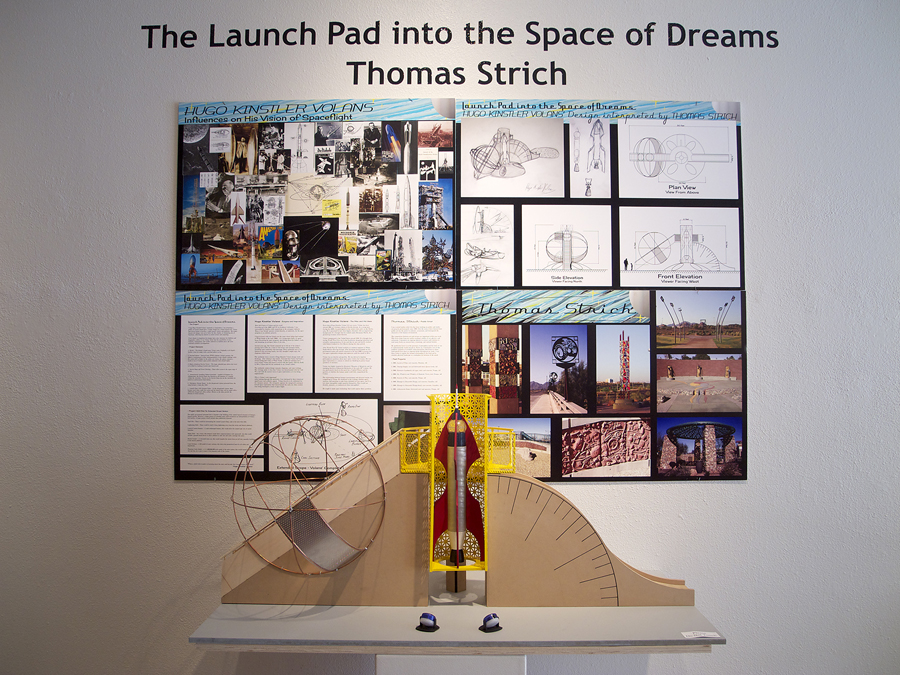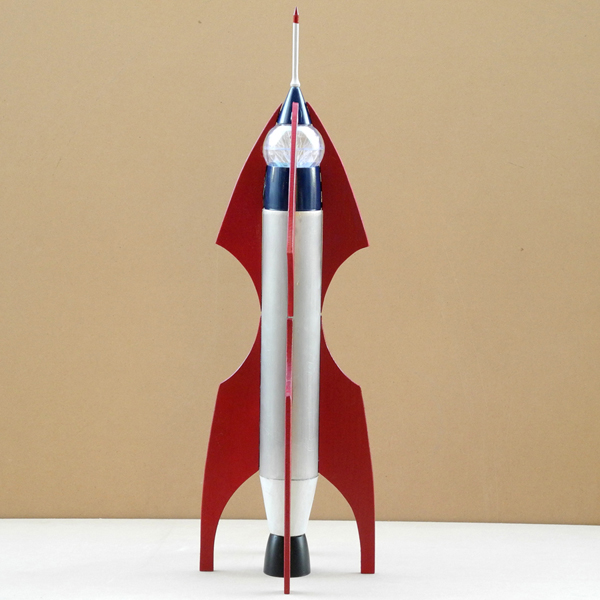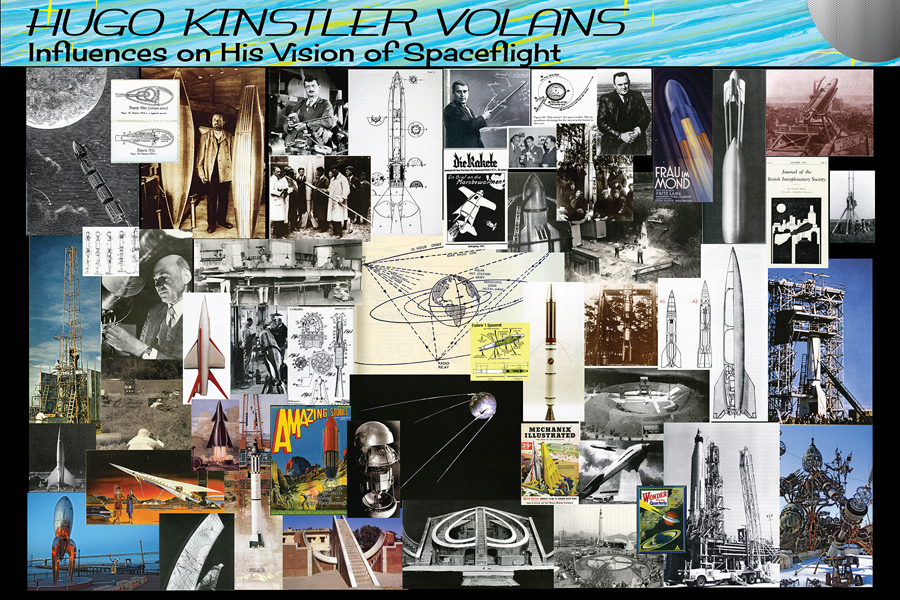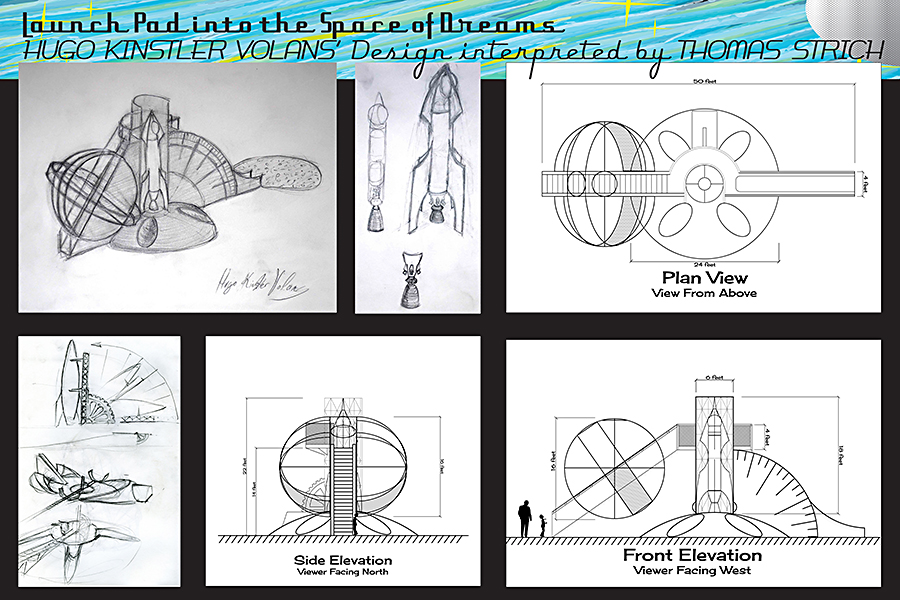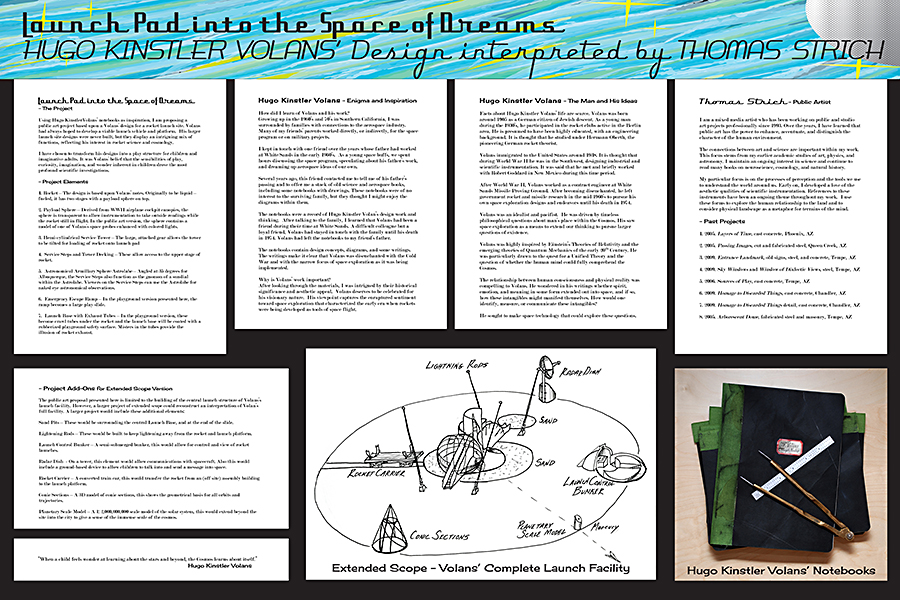This model depicts Thomas Strich’s proposal to construct a re-interpretation of Hugo Kinstler Volans’ speculated launch site. This model was presented as a proposed public art project for the City of Albuquerque, New Mexico. It was presented as one of five finalist designs for the International Symposium for Electronic Arts (ISEA) 2012 Sculpture Design Competition in Albuquerque, New Mexico. The scale of the model is 1″ to 1 ft. The completed project would be 22 feet tall and 50 feet wide.
The Launch Pad into the Space of Dreams
This display depicts Thomas Strich’s proposal to construct a re-interpretation of Hugo Kinstler Volans’ speculated launch site. This full display was presented as a proposed public art project for the City of Albuquerque, New Mexico. It was presented as one of five finalist designs for the International Symposium for Electronic Arts (ISEA) 2012 Sculpture Design Competition in Albuquerque, New Mexico.
Hugo Kinstler Volans Signature Rocket Design
Thomas Strich has embarked on a series of new works based upon the speculative history of Hugo Kinstler Volans. Hugo Kinstler Volans was an enigmatic rocket scientist from the early 20th Century, who was fascinated with space exploration and philosophical questions. Shown here is Tom’s model of Volans’ rocket design. The rocket was intended to send payloads to probe sub-orbital space. The payloads would have been held in the glass payload sphere at the top of the rocket.
Hugo Kinstler Volans’ Influences
This display board was created by Thomas Strich for the presentation of the public art proposal Launch Pad into the Space of Dreams. The public art proposal centers upon the creative reconstruction of the launch site of the enigmatic rocket scientist Hugo Kinstler Volans. This display board shows Hugo Kinstler Volans’ Influences. It is a photo collage of early rocket scientists and their developments in rocketry. It shows: Konstantin Tsiolkovsky, Hermann Oberth, Robert Goddard, Werner von Braun, and Sergei Korolev. Featured developments are: early rocket clubs of the 1930’s, the V2, the rocket from the movie “Woman in the Moon,” Sputnik, Explorer 1, rockets in science fiction, rocket launches of the early U.S. space program, and Jantar Mantar – the observatory in Jaipur India.
Launch Pad into the Space of Dreams, Project Drawings
This display board was created by Thomas Strich for the presentation of the public art proposal Launch Pad into the Space of Dreams. The public art proposal centers upon the creative reconstruction of the launch site of the enigmatic rocket scientist Hugo Kinstler Volans. This display board shows Thomas Strich’s plans to recreate the speculative launch site of Hugo Kinstler Volans. This display was presented as part of a proposed public art project for the City of Albuquerque, New Mexico. It was one of five finalist designs for the International Symposium for Electronic Arts (ISEA) 2012 Sculpture Design Competition in Albuquerque, New Mexico. Project elements shown in the drawings were explained in text by Thomas Strich that was printed on the Project Description Board. That text is reprinted here below.
Launch Pad into the Space of Dreams
– The Project
Using Hugo KinstlerVolans’ notebooks as inspiration, I am proposing a public art project based upon a Volans’ design for a rocket launch site. Volans had always hoped to develop a viable launch vehicle and platform. His larger launch site designs were never built, but they display an intriguing mix of functions, reflecting his interest in rocket science and cosmology.
I have chosen to transform his designs into a play structure for children and imaginative adults. It was Volans’ belief that the sensibilities of play, curiosity, imagination, and wonder inherent in children drove the most profound scientific investigations.
– Project Elements
1. Rocket – The design is based upon Volans’ notes. Originally to be liquid –fueled, it has two stages with a payload sphere on top.
2. Payload Sphere – Derived from WWII airplane cockpit canopies, the sphere is transparent to allow instrumentation to take outside readings while the rocket still in flight. In the public art version, the sphere contains a model of one of Volans’s space probes enhanced with colored lights.
3. Hemi-cylindrical Service Tower – The large, attached gear allows the tower to be tilted for loading of rocket onto launch pad
4. Service Steps and Tower Decking – These allow access to the upper stage of rocket.
5. Astronomical Armillary Sphere/Astrolabe – Angled at 35 degrees for Albuquerque, the Service Steps also function as the gnomon of a sundial within the Astrolabe. Viewers on the Service Steps can use the Astrolabe for naked eye astronomical observations.
6. Emergency Escape Ramp – In the playground version presented here, the ramp becomes a large play slide.
7. Launch Base with Exhaust Tubes – In the playground version, these become crawl tubes under the rocket and the launch base will be coated with a rubberized playground safety surface. Misters in the tubes provide the illusion of rocket exhaust.
Launch Pad into the Space of Dreams, Project Descriptions
“When a child feels wonder at learning about the stars and beyond, the Cosmos learns about itself.”
Hugo Kinstler Volans
This display board was created by Thomas Strich for the presentation of the public art proposal Launch Pad into the Space of Dreams. The public art proposal centers upon the creative reconstruction of the launch site of the enigmatic rocket scientist Hugo Kinstler Volans. This display board describes Thomas Strich’s plans to recreate the speculative launch site of Hugo Kinstler Volans. This display was presented as part of a proposed public art project for the City of Albuquerque, New Mexico. It was one of five finalist designs for the International Symposium for Electronic Arts (ISEA) 2012 Sculpture Design Competition in Albuquerque, New Mexico.
Along with the texts, the board includes a drawing of Volans’ Complete Launch Facility and a photograph of Volans’ Notebooks. That text elements presented on the board are reprinted here below.
Launch Pad into the Space of Dreams
– The Project
Using Hugo KinstlerVolans’ notebooks as inspiration, I am proposing a public art project based upon a Volans’ design for a rocket launch site. Volans had always hoped to develop a viable launch vehicle and platform. His larger launch site designs were never built, but they display an intriguing mix of functions, reflecting his interest in rocket science and cosmology.
I have chosen to transform his designs into a play structure for children and imaginative adults. It was Volans’ belief that the sensibilities of play, curiosity, imagination, and wonder inherent in children drove the most profound scientific investigations.
– Project Elements
1. Rocket – The design is based upon Volans’ notes. Originally to be liquid –fueled, it has two stages with a payload sphere on top.
2. Payload Sphere – Derived from WWII airplane cockpit canopies, the sphere is transparent to allow instrumentation to take outside readings while the rocket still in flight. In the public art version, the sphere contains a model of one of Volans’s space probes enhanced with colored lights.
3. Hemi-cylindrical Service Tower – The large, attached gear allows the tower to be tilted for loading of rocket onto launch pad
4. Service Steps and Tower Decking – These allow access to the upper stage of rocket.
5. Astronomical Armillary Sphere/Astrolabe – Angled at 35 degrees for Albuquerque, the Service Steps also function as the gnomon of a sundial within the Astrolabe. Viewers on the Service Steps can use the Astrolabe for naked eye astronomical observations.
6. Emergency Escape Ramp – In the playground version presented here, the ramp becomes a large play slide.
7. Launch Base with Exhaust Tubes – In the playground version, these become crawl tubes under the rocket and the launch base will be coated with a rubberized playground safety surface. Misters in the tubes provide the illusion of rocket exhaust.
– Project Add-Ons for Extended Scope Version
The public art proposal presented here is limited to the building of the central launch structure of Volans’s launch facility. However, a larger project of extended scope could reconstruct an interpretation of Volan’s full facility. A larger project would include these additional elements:
Sand Pits – These would be surrounding the central Launch Base, and at the end of the slide.
Lightening Rods – These would be built to keep lightening away from the rocket and launch platform.
Launch Control Bunker – A semi-submerged bunker, this would allow for control and view of rocket launches.
Radar Dish – On a tower, this element would allow communications with spacecraft. Also this would include a ground-based device to allow children to talk into and send a message into space.
Rocket Carrier – A converted train car, this would transfer the rocket from an (off site) assembly building to the launch platform.
Conic Sections – A 3D model of conic sections, this shows the geometrical basis for all orbits and trajectories.
Planetary Scale Model – A 1: 2,000,000,000 scale model of the solar system, this would extend beyond the site into the city to give a sense of the immense scale of the cosmos.
Hugo Kinstler Volans – Enigma and Inspiration
How did I learn of Volans and his work?
Growing up in the 1960’s and 70’s in Southern California, I was surrounded by families with connections to the aerospace industry. Many of my friends’ parents worked directly, or indirectly, for the space program or on military projects.
I kept in touch with one friend over the years whose father had worked at White Sands in the early 1960’s. As a young space buffs, we spent hours discussing the space program, speculating about his father’s work, and dreaming up aerospace ideas of our own.
Several years ago, this friend contacted me to tell me of his father’s passing and to offer me a stack of old science and aerospace books, including some notebooks with drawings. These notebooks were of no interest to the surviving family, but they thought I might enjoy the diagrams within them.
The notebooks were a record of Hugo Kinstler Volan’s design work and thinking. After talking to the family, I learned that Volans had been a friend during their time at White Sands. A difficult colleague but a loyal friend, Volans had stayed in touch with the family until his death in 1974. Volans had left the notebooks to my friend’s father.
The notebooks contain design concepts, diagrams, and some writings.
The writings make it clear that Volans was disenchanted with the Cold War and with the narrow focus of space exploration as it was being implemented.
Why is Volans’ work important?
After looking through the materials, I was intrigued by their historical significance and aesthetic appeal. Volans deserves to be celebrated for his visionary nature. His viewpoint captures the enraptured sentiment toward space exploration that characterized the early era when rockets were being developed as tools of space flight.
Hugo Kinstler Volans – The Man and His Ideas
Facts about Hugo Kinstler Volans’ life are scarce. Volans was born around 1905 as a German citizen of Jewish descent. As a young man during the 1930’s, he participated in the rocket clubs active in the Berlin area. He is presumed to have been highly educated, with an engineering background. It is thought that he studied under Hermann Oberth, the pioneering German rocket theorist.
Volans immigrated to the United States around 1938. It is thought that during World War II he was in the Southwest, designing industrial and scientific instrumentation. It was said that he met and briefly worked with Robert Goddard in New Mexico during this time period.
After World War II, Volans worked as a contract engineer at White Sands Missile Proving Ground. After becoming disenchanted, he left government rocket and missile research in the mid 1960’s to pursue his own space exploration designs and endeavors until his death in 1974.
Volans was an idealist and pacifist. He was driven by timeless philosophical questions about man’s place within the Cosmos. His saw space exploration as a means to extend our thinking to pursue larger questions of existence.
Volans was highly inspired by Einstein’s Theories of Relativity and the emerging theories of Quantum Mechanics of the early 20th Century. He was particularly drawn to the quest for a Unified Theory and the question of whether the human mind could fully comprehend the Cosmos.
The relationship between human consciousness and physical reality was compelling to Volans. He wondered in his writings whether spirit, emotion, and meaning in some form extended out into space, and if so, how these intangibles might manifest themselves. How would one identify, measure, or communicate these intangibles?
He sought to make space technology that could explore these questions.
Thomas Strich – Public Artist
I am a mixed media artist who has been working on public and studio art projects professionally since 1993. Over the years, I have learned that public art has the power to enhance, accentuate, and distinguish the character of the human environment.
The connections between art and science are important within my work. This focus stems from my earlier academic studies of art, physics, and astronomy. I maintain an ongoing interest in science and continue to read many books on neuroscience, cosmology, and natural history.
My particular focus is on the processes of perception and the tools we use to understand the world around us. Early on, I developed a love of the aesthetic qualities of scientific instrumentation. References to these instruments have been an ongoing theme throughout my work. I use these forms to explore the human relationship to the land and to consider physical landscape as a metaphor for terrains of the mind.
– Past Projects
1. 2005. Layers of Time, cast concrete, Phoenix, AZ
2. 2005. Passing Images, cut and fabricated steel, Queen Creek, AZ
3. 2009. Entrance Landmark, old signs, steel, and concrete, Tempe, AZ
4. 2009. Sky Windows and Window of Dialectic Views, steel, Tempe, AZ
5. 2006. Sources of Play, cast concrete, Tempe, AZ
6. 2009. Homage to Discarded Things, cast concrete, Chandler, AZ
7. 2009. Homage to Discarded Things detail, cast concrete, Chandler, AZ
8. 2005. Arborescent Dome, fabricated steel and masonry, Tempe, AZ
